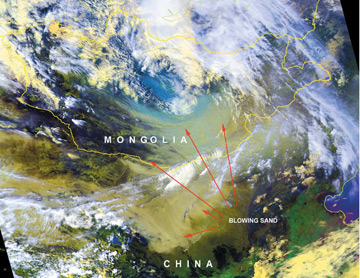Springtime sandstorms are common in China, but the spate of widespread blowing dust and sand and yellow skies in March (with five dust storms in 12 days) has many Asians worried that conditions are worsening.
The storms originate when an atmospheric low pressure feature referred to as “the Mongolian Cyclone” kicks up winds that sweep through Mongolia and across the Gobi desert, creating clouds of sand, dust, and dirt that inundate much of China. The Mongolian cyclone has been particularly intense this spring, with recent storms affecting about one-fifth of China’s 1.3 billion people, according to the state-run Xinhua News Service. And the clouds don’t stay within China’s borders; studies have shown that they can travel as far as North America, and the Korean peninsula has been hit particularly hard by this storms this year. The Korean Meteorological Administration (KMA) posted a rare yellow dust warning recently, and soon thereafter it recorded the greatest amount of the dust since it began taking measurements in 2005: 2,684 micrograms per cubic meter in Daegu (a warning is issued when the concentration exceeds 800 micrograms per cubic meter).

A recent BAMS article by Chun et al. chronicles centuries of dustfall observations in Korea and points out that the storms seem to have increased in frequency in recent years. The dust problem has intensified across much of eastern Asia as desertification in China spreads. Agriculture plays a big part, as overgrazing, expansion of farmlands, and destructive irrigation practices exacerbate already dry lands. Urban sprawl, deforestation, and just plain old dry weather also contribute. Adding to the problem are the increasing amounts of industrial pollutants that mix with the sand, dust, and soot in the clouds. The health implications can be severe and can affect people without preexisting conditions.
The Chinese government has attempted to address desertification by planting vegetation in former farmland. While the recent storms suggest that the effectiveness of these initiatives has been mixed, Chinese meteorologists point out that cold weather can explain the recent spate of dust, and that not all sandstorms should be blamed on desertification, and China’s National Satellite Meteorological Center says that the country now has about six fewer sandstorms per year than it did in the years 1971-2000.